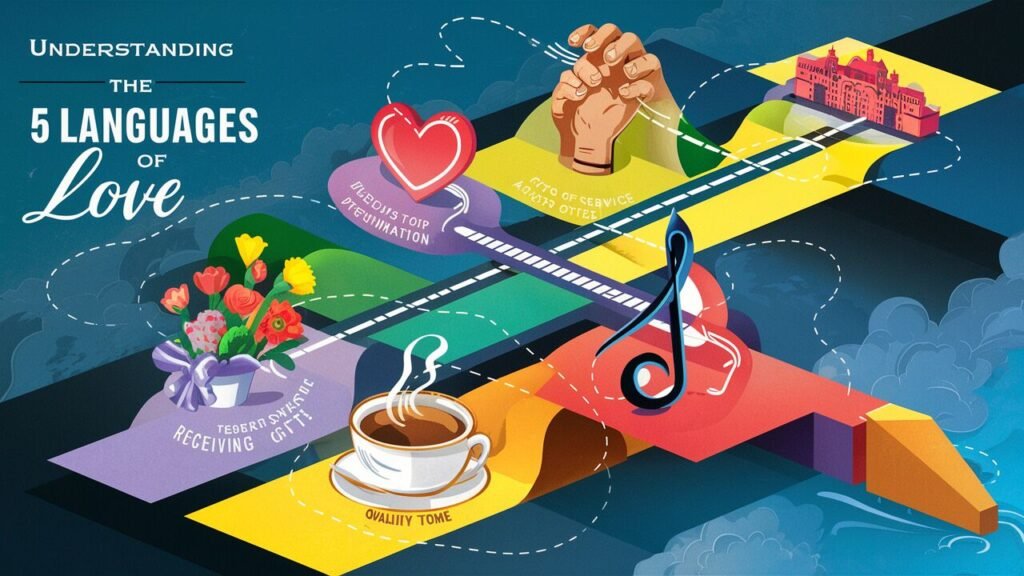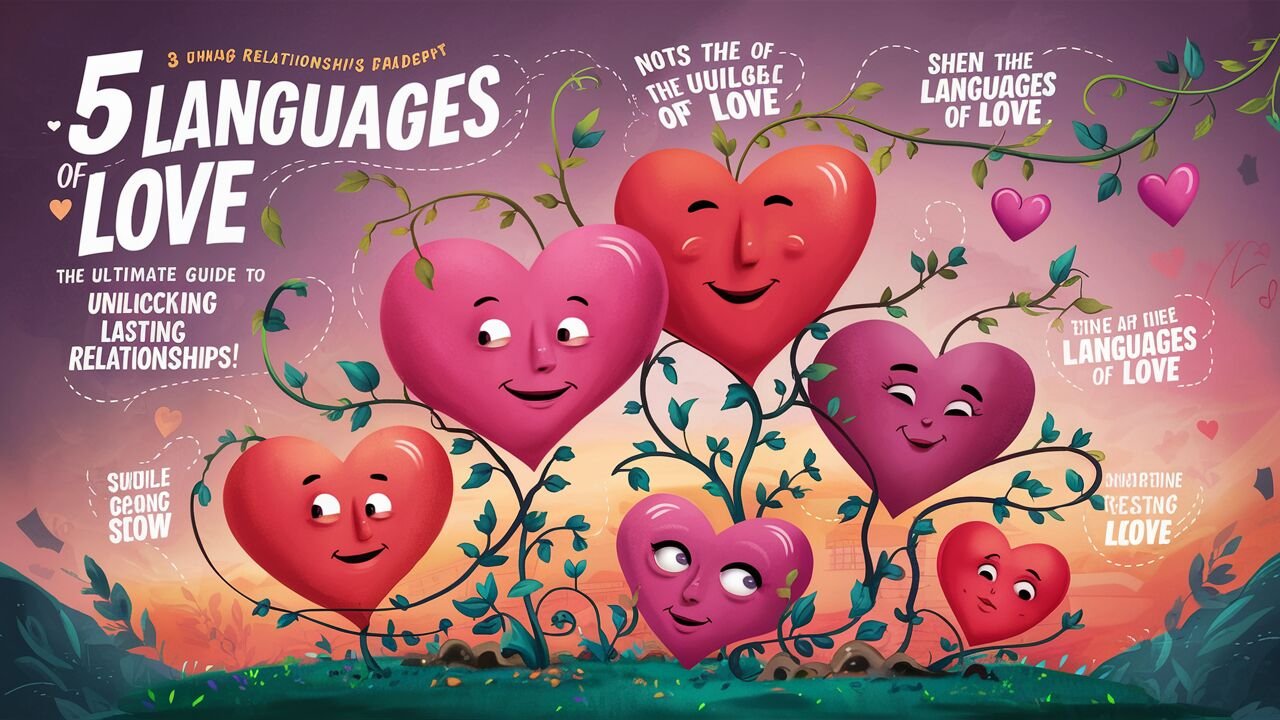Have you ever felt like you’re speaking a different language than your partner? You’re not alone! Welcome to the fascinating world of love languages, where understanding can transform your relationships. Imagine a love life where your efforts are always appreciated, your needs are met, and your bond grows stronger every day. Sounds too good to be true? It’s not! Buckle up as we embark on a journey through the 5 languages of love – your passport to deeper, more fulfilling connections.
Understanding the 5 Languages of Love: Your Roadmap to Deeper Connections

Love is a universal language, but did you know it has five distinct dialects? Dr. Gary Chapman’s groundbreaking concept of the 5 love languages has revolutionized how we understand and express affection. Let’s dive into each language and uncover the secrets to speaking love fluently.
Words of Affirmation: The Power of Verbal Expression
For some, nothing speaks louder than words. If this is your primary love language, you thrive on verbal compliments, words of appreciation, and encouraging messages. It’s not just about saying “I love you” – it’s about the daily affirmations that make you feel valued and understood.
People who prioritize words of affirmation feel most loved when their partner expresses admiration, gratitude, and support verbally. A heartfelt compliment or a simple “thank you” can make their day. If your partner speaks this language, remember that your words have immense power to uplift or deflate.
To master this language:
- Be specific with your compliments
- Express gratitude regularly
- Leave unexpected love notes
- Verbalize your feelings and appreciation often
Acts of Service: Love in Action
Actions speak louder than words for those whose primary love language is acts of service. These individuals feel most loved when their partner goes out of their way to make their life easier or more pleasant. It’s about showing love through actions, not just words.
For an acts of service person, nothing says “I love you” like doing the dishes without being asked, filling up their car with gas, or taking care of a dreaded chore. It’s the practical, tangible ways of easing their burden that truly resonate.
To excel in this language:
- Pay attention to what your partner often complains about and address those issues
- Offer to help before being asked
- Complete tasks thoroughly and with a positive attitude
- Surprise them with unexpected acts of kindness
Receiving Gifts: The Art of Thoughtful Giving

Don’t mistake this for materialism – the love language of receiving gifts is about the thought, effort, and meaning behind the gift, not its monetary value. For these individuals, a well-chosen gift serves as a physical symbol of love and appreciation.
People who value this language cherish the visual reminders of being loved. It’s not about the price tag; a wildflower picked on a walk can be just as meaningful as an expensive piece of jewelry. The key is in the thoughtfulness and the message that “you were on my mind.”
Tips for gift-giving masters:
- Keep a list of gift ideas based on things your partner mentions
- Remember important dates and celebrate with thoughtful presents
- Bring back small souvenirs when you travel
- Focus on the symbolic meaning behind gifts, not just their practical use
Love calculator: While online tools claim to measure compatibility, true love is best understood through open communication and mutual understanding of each other’s love languages.
Quality Time: Undivided Attention as an Expression of Love

In our busy, distraction-filled world, giving someone your undivided attention is a profound act of love. For those whose primary language is quality time, nothing says “I love you” more than being fully present and engaged.
Quality time isn’t just about being in the same room; it’s about focused, uninterrupted time together. This could mean deep conversations, shared activities, or simply sitting in comfortable silence. The key is being there – physically and mentally.
Strategies for quality time champions:
- Create regular date nights or special outings
- Practice active listening without interruptions or distractions
- Engage in shared hobbies or learn new skills together
- Plan trips or adventures to create shared experiences
Love calculate by name: Although some believe names can predict relationship success, focusing on learning your partner’s preferred expressions of love is a more reliable path to a strong bond.
Physical Touch: The Language of Intimacy

Physical touch as a love language goes beyond sexual intimacy. It encompasses all forms of physical affection – holding hands, hugs, kisses, and even a reassuring pat on the back. For those who speak this language, physical contact is their lifeline to feeling loved and secure in a relationship.
People who prioritize physical touch often feel most connected through tactile expressions of affection. A comforting hug after a hard day or a gentle squeeze of the hand during a conversation can speak volumes.
To become fluent in physical touch:
- Incorporate small touches into your daily interactions
- Be mindful of your partner’s comfort level with public displays of affection
- Use touch to convey support during both good and challenging times
- Explore non-sexual forms of physical intimacy, like massage or dancing together
Soulmate Sketch: Enhance your journey to find your perfect match with mystical drawings that capture the essence of your soulmate, while mastering the 5 love languages to deepen your connections with potential partners.
Discovering Your Primary Love Language: A Journey of Self-Discovery

Understanding your own love language is the first step towards more fulfilling relationships. But how do you figure out which language resonates most with you? It’s time for some introspection!
Start by reflecting on how you typically express love to others. Do you often give gifts, offer help, or use words of encouragement? Your natural way of showing love is often a clue to your own love language.
Next, think about what makes you feel most loved and appreciated. When has your partner done something that made you feel truly cherished? These moments often align with your primary love language.
You can also take the official Love Language Quiz on Dr. Chapman’s website. This assessment can provide valuable insights into your primary and secondary love languages.
Remember, while we all appreciate aspects of each language, most people have one or two that stand out as particularly meaningful. Identifying your primary language can help you communicate your needs more effectively to your partner.
It’s also crucial to understand that your love language may evolve over time. Life experiences, personal growth, and changing circumstances can shift how we give and receive love. Regular check-ins with yourself and your partner can help ensure you’re staying attuned to each other’s needs.
Two Narcissists In A Relationship: Even in relationships where both partners struggle with self-centeredness, practicing the 5 love languages can foster empathy and mutual appreciation.
Speaking Your Partner’s Love Language: The Secret to Relationship Harmony

Once you’ve identified your own love language, the next step is to decode your partner’s. This might require some detective work and open communication. Observe how they express love to you and others. What do they complain about most in relationships? What do they request from you most often? These can all be clues to their primary love language.
The key to a harmonious relationship is not just knowing each other’s languages but actively speaking them. This might mean stepping out of your comfort zone. If your language is acts of service, but your partner values words of affirmation, you’ll need to make a conscious effort to verbalize your appreciation more often.
Here are some strategies for multilingual love:
- Keep a “love language journal” to track your efforts and your partner’s responses
- Set reminders to speak your partner’s language regularly
- Ask for feedback – “Did this make you feel loved?”
- Be patient – learning a new language takes time and practice
Remember, the goal isn’t to abandon your own love language but to become bilingual in love. By speaking each other’s languages, you create a relationship where both partners feel deeply loved and understood.
Love Languages Across Different Relationship Stages: From First Date to Long-term Commitment

Love languages play a crucial role at every stage of a relationship, from those butterfly-inducing first dates to the comfortable familiarity of long-term commitment. Let’s explore how understanding love languages can enhance your relationship journey.
In the early dating phase, being aware of love languages can help you make a strong impression. Pay attention to how your date expresses appreciation and try to reciprocate in kind. Are they constantly complimenting you (words of affirmation)? Do they suggest active dates (quality time)? These could be clues to their love language.
As the relationship progresses, openly discussing love languages can deepen your connection. It’s a great way to learn about each other’s needs and expectations. This knowledge can help you navigate the sometimes tricky waters of a new relationship with greater understanding and fewer misunderstandings.
In long-term relationships or marriages, love languages become even more critical. Over time, it’s easy to fall into routines that may not align with your partner’s needs. Regularly revisiting the concept of love languages can help keep the spark alive and ensure both partners feel valued.
For couples facing challenges, understanding love languages can be a powerful tool for reconnection. Often, relationship issues stem from feeling unloved or unappreciated. By consciously speaking each other’s love languages, you can bridge gaps and rebuild intimacy.
Remember, love languages aren’t static. As you grow individually and as a couple, your preferences might shift. Regular check-ins about how you both prefer to give and receive love can keep your relationship dynamic and responsive to changing needs.
Navigating Challenges: When Love Languages Don’t Align

While love languages can be a powerful tool for connection, they can also be a source of conflict when partners speak different languages. It’s not uncommon for couples to have mismatched love languages, but with understanding and effort, these differences can strengthen rather than strain your relationship.
One common challenge is feeling like your efforts aren’t appreciated. For example, if you’re showering your partner with gifts (receiving gifts) but they’re craving more quality time, both of you might end up feeling frustrated and unloved. The key is to recognize that your partner’s preferred way of receiving love might differ from yours.
Another hurdle is the tendency to give love in the way we prefer to receive it. This natural inclination can lead to missed connections. A physical touch person might offer hugs when their partner is longing for words of affirmation.
Here are some strategies for overcoming love language mismatches:
- Practice empathy and try to see love from your partner’s perspective
- Communicate openly about your needs and listen to your partner’s without judgment
- Compromise by taking turns focusing on each other’s primary languages
- See mismatched languages as an opportunity for growth and learning
- Celebrate the diversity in your relationship – different languages can bring balance
Remember, the goal isn’t to change your natural inclinations but to expand your love vocabulary. By learning to speak each other’s languages fluently, you create a richer, more nuanced love life.
Twin flame calculator: Rather than searching for a predestined spiritual connection, cultivate a deep understanding of love languages to create a profoundly harmonious relationship with your chosen partner.
Beyond Romance: Applying the 5 Languages of Love to Family and Friendships

While often discussed in the context of romantic relationships, the 5 love languages have profound applications in all types of relationships. Understanding and applying these concepts can transform your interactions with family members, friends, and even colleagues.
In family relationships, love languages can bridge generational gaps and cultural differences. A parent who shows love through acts of service might learn to verbalize affection more for a child who values words of affirmation. Siblings with different love languages can find new ways to support and appreciate each other.
Friendships, too, can benefit from this knowledge. Recognizing a friend’s love language can help you provide support in the most meaningful way. Does your friend light up with a thoughtful gift, or do they prefer a long, uninterrupted conversation? Speaking their language can deepen your connection.
Even in professional settings, an awareness of love languages (adapted as “appreciation languages” in this context) can improve team dynamics and employee satisfaction. A manager who understands their team members’ preferred ways of receiving appreciation can tailor their recognition strategies accordingly.
Applying love languages beyond romantic relationships:
- Use love languages to resolve conflicts in family dynamics
- Show appreciation to friends in ways that resonate most with them
- Adapt the concept to improve communication in professional settings
- Teach children about love languages to help them express their needs and understand others
By extending the concept of love languages to all your relationships, you create a network of connections where everyone feels valued and understood.
Conclusion
Mastering the 5 languages of love is like acquiring a superpower for your relationships. By understanding these languages – words of affirmation, acts of service, receiving gifts, quality time, and physical touch – you unlock the secret to deeper, more fulfilling connections.
Remember, love is not one-size-fits-all. Each person has their unique way of expressing and receiving love. By learning to speak your partner’s language fluently, you create a relationship where both of you feel truly seen, heard, and cherished.
As you embark on this journey of love and understanding, keep an open mind and heart. Be patient with yourself and your loved ones as you learn and grow together. The rewards of speaking love in all its languages are immeasurable – stronger bonds, deeper intimacy, and a love that stands the test of time.
So, are you ready to become fluent in the language of love? Your journey to extraordinary relationships starts now!
FAQ about 5 Languages of Love
Q: Can a person have more than one primary love language?
A: Yes, it’s possible to have two love languages that are equally important to you. Some people may strongly resonate with multiple languages.
Q: Do love languages change over time?
A: Love languages can evolve as we grow and experience life changes. It’s good to reassess your love language periodically.
Q: How can I figure out my partner’s love language if they’re not familiar with the concept?
A: Observe how they express love to you and others, what they complain about in the relationship, and what they request from you most often.
Q: Is it possible for couples with different love languages to have a successful relationship?
A: Absolutely! Differences in love languages can actually strengthen a relationship if both partners are willing to learn and speak each other’s languages.
Q: How often should we discuss love languages in our relationship?
A: It’s beneficial to have regular check-ins, perhaps every few months or whenever you feel there’s a disconnect in how love is being expressed or received.
Q: Can understanding love languages help in resolving conflicts?
A: Yes, many conflicts arise from feeling unloved or unappreciated. Understanding each other’s love languages can help address these issues more effectively.
Q: Are there cultural differences in how love languages are expressed?
A: Yes, cultural background can influence how love languages are expressed and interpreted. It’s important to consider cultural context in understanding love languages.
